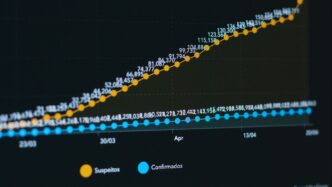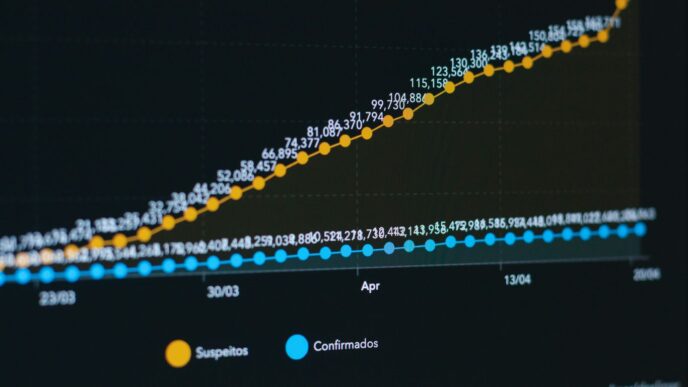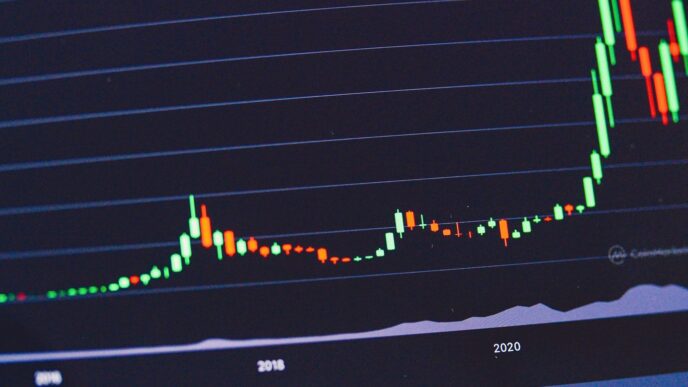The world of cloud software, or SaaS, is really taking off. It’s not just a passing trend; it’s useful for businesses right now. We’re going to look at what makes SaaS companies tick, especially those that are publicly traded. We’ll cover how big the market is, who’s leading the pack, and what it takes to sell these kinds of products in 2025. It’s a complex space, but understanding it can really help you see where things are headed.
Key Takeaways
- The global SaaS market is huge and keeps growing, with many companies based in the US, and it’s expected to be worth hundreds of billions soon.
- Big names like Salesforce are major players, but new startups are also shaking things up and bringing fresh ideas to the table.
- Selling SaaS is different from selling regular software; it’s all about building ongoing relationships and showing clear value over time.
- How you sell SaaS is changing, with models like Product-Led Growth and Self-Serve becoming more common, alongside community efforts.
- Keeping an eye on metrics like Customer Lifetime Value (LTV) and Customer Acquisition Cost (CAC) is super important for knowing if your SaaS business is healthy and growing smart.
Understanding The SaaS Market Landscape
Alright, let’s talk about the world of Software as a Service, or SaaS, as it stands heading into 2025. It’s a massive space, and honestly, it’s not just a trend anymore; it’s how a lot of businesses get things done. Think about it – instead of buying software outright and dealing with installations and updates, you just pay a subscription and use it online. Pretty neat, right?
Global SaaS Market Size and Growth Projections
The numbers here are pretty wild. We’re seeing steady growth, and it’s not slowing down much. While the average number of SaaS apps a company uses might have dipped a tiny bit recently, the overall market is still expanding. We’re talking about a market that’s expected to keep climbing, reaching hundreds of billions of dollars. This growth is fueled by how easy SaaS makes things for businesses.
Regional Distribution of SaaS Companies
So, where are all these SaaS companies? The United States is definitely the big player, with a huge chunk of the global companies calling it home. After that, you see significant numbers in places like the UK and Canada. Germany, France, and India also have a good presence. It’s interesting to see how the landscape is spread out, though the US really dominates the scene. This concentration means a lot of innovation and competition often starts there. You can find more details on SaaS market statistics for 2025.
Key Benefits Driving SaaS Adoption
Why is everyone jumping on the SaaS train? Well, there are some pretty clear reasons:
- Accessibility: You can get to your software from pretty much anywhere with an internet connection. No more being tied to a specific office computer.
- Cost-Effectiveness: For many businesses, especially smaller ones, paying a monthly or annual fee is way more manageable than a big upfront software purchase. Plus, you often avoid costly hardware upgrades.
- Automatic Updates: This is a big one. The software provider handles all the updates and maintenance, so you’re always on the latest version without lifting a finger. It saves a ton of IT hassle.
- Scalability: Need more users or features? With SaaS, it’s usually just a matter of adjusting your subscription. You can scale up or down as your business needs change, which is super flexible.
Navigating The Competitive SaaS Ecosystem
The SaaS market is buzzing, and honestly, it feels like there’s a new company popping up every other day. It’s a good thing for businesses looking for solutions, but it can make things tricky for sales teams trying to stand out. We’re talking about a global market that’s expected to hit around $390.5 billion by 2026, so there’s definitely a lot of money to be made, but you’ve got to be smart about it. The United States is a huge hub, with a massive number of SaaS companies, but places like the UK and Canada are also growing fast.
Leading SaaS Companies and Their Market Share
When you look at the big players, names like Microsoft, Salesforce, Oracle, SAP, and Google are pretty much everywhere. They’ve got a solid grip on different parts of the market. It’s tough for smaller companies to go head-to-head with these giants, but they often find their niche. Understanding who holds what share helps you see where the biggest opportunities and the toughest competition lie. It’s a dynamic landscape, and these market shares can shift, especially with new tech coming out.
Emerging SaaS Startups and Unicorns
But it’s not just the big guys. There’s a whole wave of startups and ‘unicorns’ – those private companies valued at over a billion dollars – that are shaking things up. Think about companies like Zoom or Shopify that started smaller and grew into massive forces. These newer companies are often more agile and can bring fresh ideas to the table. They’re not afraid to try new things, which is great for innovation across the board. It’s worth keeping an eye on these companies, both as potential competitors and as examples of what’s possible. You can find some great tools to help you track these companies and understand their strategies for competitive intelligence.
Impact of Startups on Industry Innovation
These startups are really the engine for a lot of the changes we see in the SaaS world. They push established companies to adapt and improve. Because they don’t have the same legacy systems or established customer bases, they can experiment more freely. This often leads to better products, more creative sales approaches, and ultimately, more choices for customers. They force everyone to keep up, which is a win for the whole industry. It means that even if you’re a smaller player, you can still make a big splash if you’ve got the right idea and execution.
Strategies For Success In SaaS Sales
Selling software as a service isn’t quite like selling, say, a physical product. For one thing, you’re not just selling a thing; you’re selling access to a service that customers pay for over time. This subscription model means the sale really kicks off after the contract is signed. Keeping customers happy and getting them to stick around is just as important, if not more so, than landing that initial deal. It’s a whole different ballgame.
The Unique Dynamics of SaaS Sales
So, what makes SaaS sales stand out? Well, it’s mostly that subscription bit. Instead of a big upfront payment, you’ve got recurring revenue. This means your sales team has to work hand-in-hand with customer success folks to make sure people actually use the software and don’t cancel. Plus, B2B SaaS deals can take a while – think months, not days. There are lots of people involved in the decision, and they need to be convinced not just by the features, but by the real value and return on investment. You’ve got to educate them, show them how it fits into their workflow, and be patient.
Essential Elements of A Killer SaaS Sales Strategy
To really nail SaaS sales, you need a solid plan. It’s not just about having a good product; it’s about how you sell it. Here are some key things to focus on:
- Know Your Customer: Figure out exactly who you’re selling to. What are their pain points? What do they really need?
- Map the Buyer’s Journey: Understand every step a potential customer takes from first hearing about you to becoming a loyal user. Your sales process should match this journey.
- Educate and Demonstrate Value: Since customers need to understand how your software changes their work, demos, webinars, and case studies are super important. Show them the ROI.
- Focus on Retention: Happy customers are repeat customers. Make sure onboarding is smooth and that customers are getting ongoing value. This is where customer success teams shine.
- Track Your Numbers: Keep a close eye on metrics like Customer Lifetime Value (LTV) and Customer Acquisition Cost (CAC). You want your LTV to be significantly higher than your CAC – a 3:1 ratio is a good target.
Aligning Sales Processes With The Buyer’s Journey
Think about it from the customer’s point of view. They’re not just looking for a product; they’re looking for a solution to a problem. Your sales process needs to reflect that. When someone is just becoming aware of a problem, you might offer helpful content. When they’re comparing options, you need to show them why you’re the best fit. This alignment means your sales team is there to help, not just to push a sale. It builds trust and makes the whole experience better for everyone involved, leading to more successful, long-term customer relationships.
Evolution Of SaaS Sales Models
The way software companies sell their products has really changed over the years, especially with the rise of Software as a Service. It’s not just about making a sale and moving on anymore. We’ve seen a few main ways companies approach selling SaaS, and each has its own vibe.
Product-Led Growth vs. Sales-Led Growth
Think about Product-Led Growth, or PLG. This is where the software itself is the main salesperson. People can often try it out for free or with a trial, and if they like it, they start paying. It’s all about letting the product do the heavy lifting. This works well for software that’s pretty easy to figure out and shows its value quickly. Companies like Slack and Zoom really made this popular.
On the other hand, Sales-Led Growth (SLG) is more traditional. Here, you have a sales team actively reaching out to potential customers, giving demos, and closing deals. This model is usually for more complex or expensive software, often sold to bigger businesses where a personal touch and detailed explanation are needed. Think of big enterprise software solutions. The choice between PLG and SLG often depends on how complex your product is and who you’re selling to. Many companies even mix these approaches, using PLG for smaller customers and SLG for larger ones.
The Rise Of Self-Serve Models
This ties into PLG, but self-serve is really about giving customers the power to do everything themselves. From signing up and paying to setting up and using the software, they don’t need to talk to anyone. This is great for simple tools or for customers who know exactly what they want and how to get it. It cuts down on costs for the company and can be super fast for the customer. You see this a lot with smaller apps or specific features within larger platforms.
Community-Led Growth Strategies
This is a newer, but increasingly important, way to sell. Community-Led Growth means building a strong group of users around your product. These users help each other, share tips, and even become advocates for the software. The company facilitates this community, maybe through forums, user groups, or events. When people see others getting value and helping each other out, it builds trust and encourages new people to join. It’s less about direct selling and more about building a loyal following that naturally brings in new customers. It’s like word-of-mouth on steroids, powered by a shared interest in the product.
Key Metrics For SaaS Business Success
Alright, so you’ve got your SaaS product humming along, and maybe you’re even making some sales. That’s great! But how do you really know if you’re on the right track? It’s not just about how many deals you close today; it’s about building something that lasts. That’s where keeping an eye on the right numbers comes in. Think of these metrics as your dashboard for the business – they tell you what’s working, what’s not, and where you need to steer the ship.
Understanding Customer Lifetime Value (LTV)
This one’s pretty straightforward, really. Customer Lifetime Value, or LTV, is basically the total amount of money you expect to get from a single customer over the entire time they’re with you. It’s not just about that first payment; it’s about all the renewals, upgrades, and extra bits they might buy down the road. Knowing your LTV helps you understand how much a customer is truly worth to your business. If you have a high LTV, it means customers stick around and keep paying, which is exactly what you want for steady income.
Optimizing Customer Acquisition Cost (CAC)
On the flip side, you’ve got Customer Acquisition Cost, or CAC. This is what it costs you, in terms of marketing and sales effort, to get a new customer through the door. You add up all your spending on ads, sales team salaries, commissions, and so on, and then divide it by how many new customers you signed up in that period. It’s easy to spend too much here, especially when you’re trying to grow fast. The trick is to find ways to bring that cost down without sacrificing quality leads. Maybe you get better at targeting your ads, or your sales team gets more efficient.
The Importance Of The LTV:CAC Ratio
Now, here’s where things get really interesting. You can’t just look at LTV and CAC in isolation. You need to see how they stack up against each other. This is your LTV to CAC ratio. A common benchmark is to aim for a ratio of 3:1 or higher. That means for every dollar you spend to get a customer, you should be getting at least three dollars back over their lifetime. If your ratio is too low, you might be spending too much to get customers, and that’s not sustainable. If it’s super high, you might be missing opportunities to invest more in growth. It’s all about finding that sweet spot.
Here’s a quick look at what different ratios might suggest:
- 1:1 Ratio: You’re likely losing money on every new customer.
- 3:1 Ratio: This is generally considered healthy and sustainable.
- 5:1 Ratio: You might be under-investing in growth and could potentially acquire more customers profitably.
Keeping these numbers in check is how you build a solid, long-term SaaS business, not just a flash in the pan.
Emerging Trends Shaping SaaS Sales In 2025

The SaaS market is really heating up, and how we sell these cloud-based tools is changing fast. It’s not just about having a good product anymore; it’s about how you connect with customers and make their lives easier. By 2025, the way we approach SaaS sales is getting a serious upgrade, driven by smarter tech and a better understanding of what buyers actually want.
AI-Powered Sales Assistants And Automation
Think of AI as your new sales sidekick. These tools are getting really good at handling the grunt work, freeing up salespeople to focus on building relationships and closing bigger deals. We’re talking about AI that can help with:
- Lead Qualification: Automatically sifting through leads to find the ones most likely to buy.
- Meeting Scheduling: Taking the back-and-forth out of booking appointments.
- Personalized Outreach: Crafting emails and messages that actually sound like they’re written by a human, tailored to each prospect.
- Data Entry: Filling in CRM fields so reps don’t have to.
This isn’t about replacing salespeople; it’s about making them more effective. Imagine having an assistant that never sleeps and can process information faster than anyone. That’s what AI is bringing to the table.
Leveraging Data For Informed Decision-Making
Data is king, and in 2025, it’s more accessible and actionable than ever. Companies are getting serious about using data to understand their customers and their own sales performance. This means looking at:
- Customer Behavior: What features are users actually using? When do they seem to get stuck?
- Sales Pipeline Health: Where are deals stalling? Which sales activities are leading to closed wins?
- Market Trends: What are competitors doing? What are customers asking for?
By digging into this information, sales teams can make smarter choices about where to focus their energy. It helps them identify which prospects are the best fit and how to talk to them in a way that makes sense. This data-driven approach is key to staying ahead in the competitive SaaS marketing landscape.
Tailoring Messaging For Diverse Stakeholders
Buyers aren’t just one person anymore. When a company is looking to buy SaaS, there are usually several people involved – from the end-user who will use the software daily to the IT manager concerned with security and integration, and the finance department looking at the budget. Each of these people cares about different things.
- The User: Wants to know how it makes their job easier and more efficient.
- The IT Manager: Needs to understand security protocols, integration capabilities, and technical support.
- The Decision Maker (e.g., VP/CFO): Focuses on ROI, cost savings, and strategic business impact.
In 2025, successful SaaS sales teams will be masters at crafting different messages for each of these groups. It’s about speaking their language and showing them how the product solves their specific problems. This personalized communication builds trust and makes it much easier to get everyone on board.
Wrapping It Up
So, that’s the big picture for SaaS in 2025. It’s clear this whole software-as-a-service thing isn’t going anywhere. It’s grown a ton, and honestly, it just makes sense for a lot of businesses today. We’ve seen how many companies are out there now, and how much money is being made. It’s not just the big players either; new startups are popping up with fresh ideas all the time. Whether you’re building a SaaS product or trying to sell one, it’s a busy market, but there are definitely ways to find your spot and grow. Keep an eye on what’s new, and remember that making things easier for customers is usually the best way forward.
Frequently Asked Questions
What exactly is SaaS and why is it so popular?
SaaS stands for Software as a Service. Think of it like renting software instead of buying it. You use it over the internet, usually by paying a monthly or yearly fee. It’s popular because it’s easy to access from anywhere, often cheaper upfront than buying software outright, and companies handle all the updates and maintenance for you, making life simpler.
How big is the SaaS market right now?
The SaaS market is huge and keeps getting bigger! By 2025, there are tens of thousands of SaaS companies all around the world. Experts predict the market will be worth hundreds of billions of dollars soon, showing just how much businesses rely on these services.
Where are most SaaS companies located?
The United States is home to the most SaaS companies, making up more than half of them globally. Other countries like the United Kingdom and Canada also have a good number of these companies, along with places like Germany, France, and India.
What’s the difference between selling regular software and SaaS?
Selling regular software is often a one-time deal. With SaaS, it’s more about building a long-term relationship because customers pay over time. This means keeping customers happy and making sure they keep using the service is just as important as getting them to sign up in the first place. It’s less about a single big sale and more about steady, ongoing value.
What does ‘Product-Led Growth’ mean in SaaS sales?
Product-Led Growth, or PLG, is when the software itself helps sell the product. Imagine a free version or a trial that lets people use the software and see how great it is. They might get hooked and decide to pay for more features or a full subscription without a salesperson even needing to convince them. The product does the heavy lifting.
What are some new trends in SaaS sales for 2025?
In 2025, AI is playing a bigger role, helping sales teams with tasks and providing smart insights. Companies are also using more data to understand customers better and make smarter decisions. Plus, tailoring how they talk to different people within a company is becoming super important to make sure everyone understands the value.














